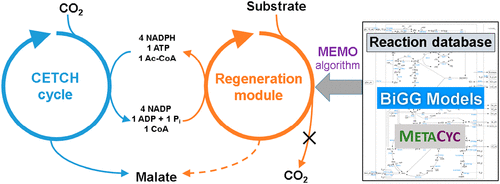当前位置:
X-MOL 学术
›
ACS Synth. Biol.
›
论文详情
Our official English website, www.x-mol.net, welcomes your
feedback! (Note: you will need to create a separate account there.)
MEMO: A Method for Computing Metabolic Modules for Cell-Free Production Systems.
ACS Synthetic Biology ( IF 3.7 ) Pub Date : 2020-03-02 , DOI: 10.1021/acssynbio.9b00434 Axel von Kamp 1 , Steffen Klamt 1
ACS Synthetic Biology ( IF 3.7 ) Pub Date : 2020-03-02 , DOI: 10.1021/acssynbio.9b00434 Axel von Kamp 1 , Steffen Klamt 1
Affiliation

|
Cell-free bioproduction systems represent a promising alternative to classical microbial fermentation processes to synthesize value-added products from biological feedstocks. An essential step for establishing cell-free production systems is the identification of suitable metabolic modules with defined properties. Here we present MEMO, a novel computational approach to find smallest metabolic modules with specified stoichiometric and thermodynamic constraints supporting the design of cell-free systems in various regards. In particular, one key challenge for a sustained operation of cell-free systems is the regeneration of utilized cofactors (such as ATP and NAD(P)H). Given a production pathway with certain cofactor requirements, MEMO can be used to compute smallest regeneration modules that recover these cofactors with required stoichiometries. MEMO incorporates the stoichiometric and thermodynamic constraints in a single mixed-integer linear program, which can then be solved to find smallest suitable modules from a given reaction database. We illustrate the applicability of MEMO by calculating regeneration modules for the recently published synthetic CETCH cycle for in vitro carbon dioxide fixation. We demonstrate that MEMO is very flexible in taking into account the diverse constraints of the CETCH cycle (e.g., regeneration of 1 ATP, 4 NADPH and of 1 acetyl-group without net production of CO2 and with permitted side production of malate) and is able to determine multiple solutions in reasonable time in two large reaction databases (MetaCyc and BiGG). The most promising regeneration modules found utilize glycerol as substrate and require only 8 enzymatic steps. It is also shown that some of these modules are robust against spontaneous loss of cofactors (e.g., oxidation of NAD(P)H or hydrolysis of ATP). Furthermore, we demonstrate that MEMO can also find cell-free production systems with integrated product synthesis and cofactor regeneration. Overall, MEMO provides a powerful method for finding metabolic modules and for designing cell-free production systems as one particular application.
中文翻译:

MEMO:一种用于无细胞生产系统的代谢模块的计算方法。
无细胞生物生产系统代表了经典微生物发酵工艺从生物原料合成增值产品的有希望的替代方法。建立无细胞生产系统的重要步骤是确定具有定义特性的合适代谢模块。在这里,我们介绍了MEMO,这是一种新颖的计算方法,可以找到具有指定化学计量和热力学约束的最小代谢模块,从而在各个方面支持无细胞系统的设计。特别是,无细胞系统持续运行的一个关键挑战是利用的辅因子(如ATP和NAD(P)H)的再生。给定具有某些辅助因子要求的生产途径,MEMO可用于计算最小的再生模块,以所需的化学计量比回收这些辅助因子。MEMO在单个混合整数线性程序中合并了化学计量和热力学约束,然后可以对其进行求解,以从给定的反应数据库中找到最小的合适模块。我们通过计算用于体外二氧化碳固定的最近发布的合成CETCH循环的再生模块来说明MEMO的适用性。我们证明,MEMO在考虑CETCH循环的多种限制方面非常灵活(例如,再生1 ATP,4 NADPH和1乙酰基而没有净生产CO2和允许的苹果酸副产),并且能够在两个大型反应数据库(MetaCyc和BiGG)中在合理的时间内确定多种溶液。发现最有前途的再生模块利用甘油作为底物,仅需8个酶促步骤。还显示出这些模块中的一些模块对辅因子的自发损失(例如NAD(P)H的氧化或ATP的水解)具有较强的抵抗力。此外,我们证明MEMO也可以找到具有集成产品合成和辅因子再生功能的无细胞生产系统。总体而言,MEMO提供了一种功能强大的方法来查找代谢模块,并将无细胞生产系统设计为一种特殊应用。
更新日期:2020-03-03
中文翻译:

MEMO:一种用于无细胞生产系统的代谢模块的计算方法。
无细胞生物生产系统代表了经典微生物发酵工艺从生物原料合成增值产品的有希望的替代方法。建立无细胞生产系统的重要步骤是确定具有定义特性的合适代谢模块。在这里,我们介绍了MEMO,这是一种新颖的计算方法,可以找到具有指定化学计量和热力学约束的最小代谢模块,从而在各个方面支持无细胞系统的设计。特别是,无细胞系统持续运行的一个关键挑战是利用的辅因子(如ATP和NAD(P)H)的再生。给定具有某些辅助因子要求的生产途径,MEMO可用于计算最小的再生模块,以所需的化学计量比回收这些辅助因子。MEMO在单个混合整数线性程序中合并了化学计量和热力学约束,然后可以对其进行求解,以从给定的反应数据库中找到最小的合适模块。我们通过计算用于体外二氧化碳固定的最近发布的合成CETCH循环的再生模块来说明MEMO的适用性。我们证明,MEMO在考虑CETCH循环的多种限制方面非常灵活(例如,再生1 ATP,4 NADPH和1乙酰基而没有净生产CO2和允许的苹果酸副产),并且能够在两个大型反应数据库(MetaCyc和BiGG)中在合理的时间内确定多种溶液。发现最有前途的再生模块利用甘油作为底物,仅需8个酶促步骤。还显示出这些模块中的一些模块对辅因子的自发损失(例如NAD(P)H的氧化或ATP的水解)具有较强的抵抗力。此外,我们证明MEMO也可以找到具有集成产品合成和辅因子再生功能的无细胞生产系统。总体而言,MEMO提供了一种功能强大的方法来查找代谢模块,并将无细胞生产系统设计为一种特殊应用。











































 京公网安备 11010802027423号
京公网安备 11010802027423号